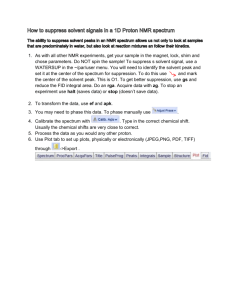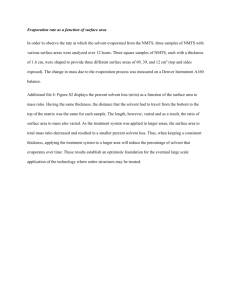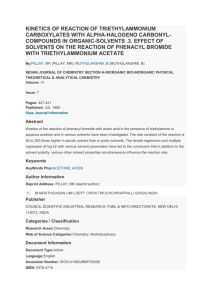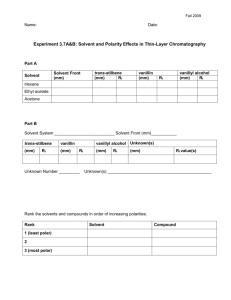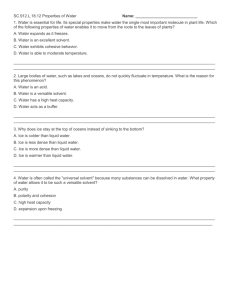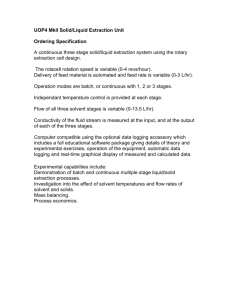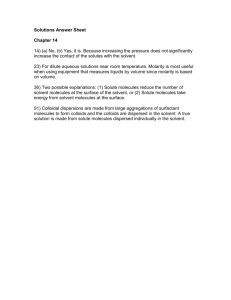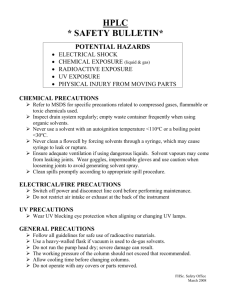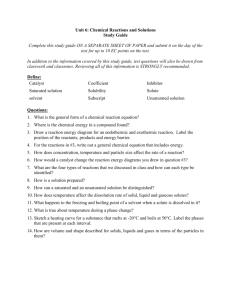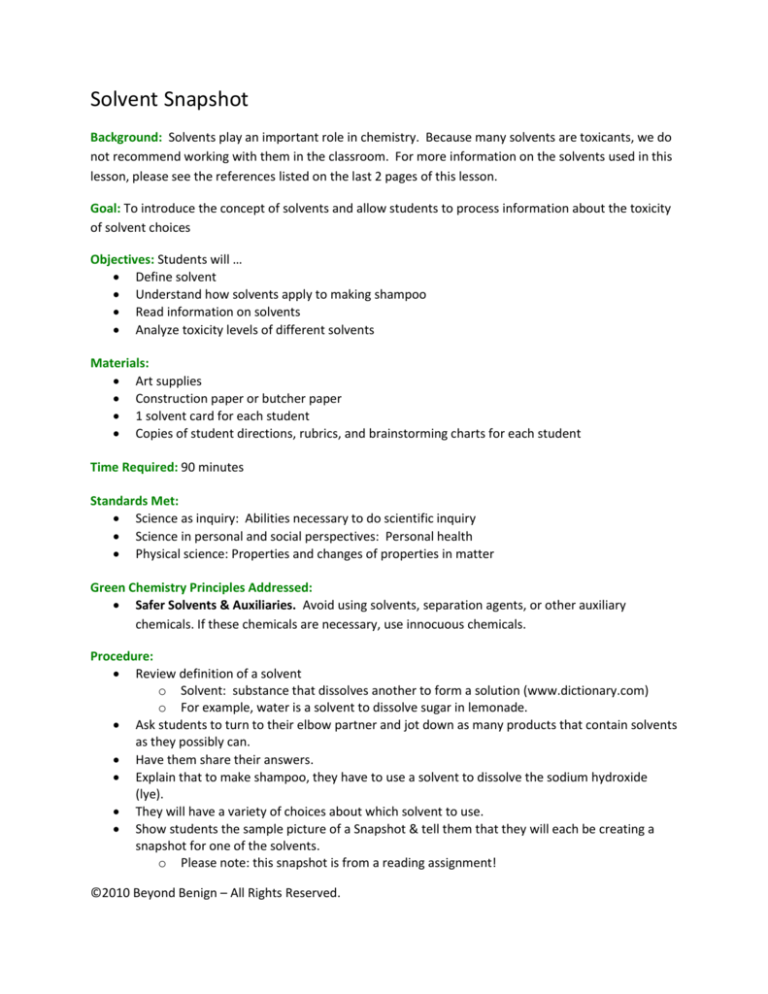
Solvent Snapshot
Background: Solvents play an important role in chemistry. Because many solvents are toxicants, we do
not recommend working with them in the classroom. For more information on the solvents used in this
lesson, please see the references listed on the last 2 pages of this lesson.
Goal: To introduce the concept of solvents and allow students to process information about the toxicity
of solvent choices
Objectives: Students will …
Define solvent
Understand how solvents apply to making shampoo
Read information on solvents
Analyze toxicity levels of different solvents
Materials:
Art supplies
Construction paper or butcher paper
1 solvent card for each student
Copies of student directions, rubrics, and brainstorming charts for each student
Time Required: 90 minutes
Standards Met:
Science as inquiry: Abilities necessary to do scientific inquiry
Science in personal and social perspectives: Personal health
Physical science: Properties and changes of properties in matter
Green Chemistry Principles Addressed:
Safer Solvents & Auxiliaries. Avoid using solvents, separation agents, or other auxiliary
chemicals. If these chemicals are necessary, use innocuous chemicals.
Procedure:
Review definition of a solvent
o Solvent: substance that dissolves another to form a solution (www.dictionary.com)
o For example, water is a solvent to dissolve sugar in lemonade.
Ask students to turn to their elbow partner and jot down as many products that contain solvents
as they possibly can.
Have them share their answers.
Explain that to make shampoo, they have to use a solvent to dissolve the sodium hydroxide
(lye).
They will have a variety of choices about which solvent to use.
Show students the sample picture of a Snapshot & tell them that they will each be creating a
snapshot for one of the solvents.
o Please note: this snapshot is from a reading assignment!
©2010 Beyond Benign – All Rights Reserved.
Give each student a student direction sheet and review the requirements. Also pass out the
grading rubric and review the expectations.
Give each student one solvent card & an industry solvent guide
o Please note! The cards are differentiated. Water is the easiest reading level. Benzene
is grade level. Dichloromethane is the most difficult.
o Please note! The International Programme on Chemical Safety does not have an
International Chemical Safety Card on water. The card included here was developed by
Beyond Benign staff.
Allow them time to read the cards.
As they are reading, give students brainstorming charts and allow them to complete the charts
for their solvent.
Give students the final copy paper and art supplies and allow them to complete their Solvent
Snapshots
Once they are completed, jigsaw students to share the information about each solvent.
Write the principle below on the board and review what it means
o Safer Solvents & Auxiliaries. Avoid using solvents, separation agents, or other auxiliary
chemicals. If these chemicals are necessary, use innocuous chemicals.
Have students get into their shampoo groups to determine which solvent they would like to use.
Sample Snapshot:
©2010 Beyond Benign – All Rights Reserved.
Solvent Snapshot – Student Directions
Solvent: substance that dissolves another to form a solution (www.dictionary.com) For example, water
is a solvent to dissolve sugar in lemonade.
To make shampoo, the sodium hydroxide must be dissolved in a solvent. Chemists frequently have
choices about which solvent to use, and they have to weigh the risks and benefits of different solvents.
In order to help you choose which solvent to use, each student will make a solvent snapshot and share
the information with the class.
A solvent snapshot uses words to create a picture of a certain solvent. Your snapshot will create a
picture of one of the solvents you might use to make your shampoo. You will need to:
1. Read the solvent card given to you by your teacher
2. For one of the solvents, brainstorm words related to:
a. overall toxicity: words to describe the general toxicity level of your solvent, is it safe?
Not very dangerous? Extremely harmful?
b. human impacts: words to describe how humans may be affected by your solvent, both
short and long term
c. lab safety: words to describe how safe this solvent is to use in a lab setting, consider
storage, safety precautions (need gloves, safety glasses, respirator...), explosiveness,
transportation
d. environmental impacts: words to describe how the environment may be affected by
your solvent
3. You will need to include an explanation of significance of each of your words on the charts given
to you.
4. You will use a color-coded key to distinguish between different aspects of the solvent.
a. For example, all of your words relating to the human impacts would be in blue, or all of
your words relating to the environmental impacts would be green.
b. Your color choices should reflect how benign or toxic the solvent is.
c. Be sure to include the color key on your final product.
©2010 Beyond Benign – All Rights Reserved.
Solvent Snapshot: Brainstorming Charts
Directions: Brainstorm words for each chart. You need to have as many words as there are spaces. You
may not use any word (or form of that word) more than once!
Overall toxicity
word
why you included it
Human Impacts
word
©2010 Beyond Benign – All Rights Reserved.
why you included it
Lab safety
word
why you included it
Environmental Impacts
word
©2010 Beyond Benign – All Rights Reserved.
why you included it
Solvent Snapshot: Grading Rubric
5
Content
Vocabulary
Neatness
&
Creativity
Color Choice
Spelling
This clearly,
creatively, &
accurately
gives
information
about the
solvent.
All words are
varied &
mature.
Extremely
easy to read.
Illustrations &
word design is
impressive.
Michelangelo
has nothing
on you!
Clearly
reflects the
toxicity level
of the solvent.
Key is
included and
very easy to
understand.
0
mistakes
4
2
1
Some of your
project
accurately
gives
information
about the
solvent; more
than 2 items
were incorrect
or confusing.
Your project
misinforms a
reader about
the solvent.
The
information is
incorrect &
incomplete.
Most words are
varied & right
on tract.
Some words
are varied &
right on track.
Words repeat
& are below
grade level
OR you are
missing
many.
Legible
Barely legible
Illustrations &
word design
helps convey
meaning.
Illustrations &
word design is
complete, but
challenging to
understand.
Illustrations &
word design is
complete, but
lacking in
thoughtfulness.
Illustrations &
word design
is incomplete
& uninspiring.
Reflects the
toxicity level
of the
solvent. Key
is included
and easy to
understand.
Mostly reflects
the toxicity
level of the
solvent. Key is
included and
mostly
understandable.
Some of your
colors do not
reflect the
toxicity level of
the solvent.
Key is included.
Most of your
colors do not
reflect the
toxicity level
of the
solvent. Key
is missing.
1-2
mistakes
3-4
mistakes
5-6
mistakes
More than 6
mistakes
This
accurately
gives
information
about the
solvent.
All words are
varied & right
on track.
Easy to read
©2010 Beyond Benign – All Rights Reserved.
3
Most of your
project
accurately gives
information
about the
solvent; one or
two items were
confusing.
illegible
Solvent Snapshot - Solvent Card: Dichloromethane
Dichloromethane is not without its health risks as its high volatility makes it an acute inhalation
hazard.[4] Dichloromethane is also metabolised by the body to carbon monoxide potentially leading to
carbon monoxide poisoning.[5] Acute exposure by inhalation has resulted in optic neuropathy[6] and
hepatitis.[7] Prolonged skin contact can result in the dichloromethane dissolving some of the fatty tissues
in skin, resulting in skin irritation or chemical burns.[8]
It may be carcinogenic, as it has been linked to cancer of the lungs, liver, and pancreas in laboratory
animals.[9] Dichloromethane crosses may be harmful to babies in the womb. Fetal toxicity in women
who are exposed to it during pregnancy however has not been proven.[10] In animal experiments it was
toxic for a fetus at doses that were maternally .
In many countries products containing dichloromethane must carry labels warning of its health risks.
In the European Union, the European Parliament voted in 2009 to ban the use of dichloromethane in
paint-strippers for consumers and many professionals.
DICHLOROMETHANE: International Chemical Safety Card
TYPES OF HAZARD /
EXPOSURE
ACUTE HAZARDS /
SYMPTOMS
EXPLOSION
Risk of fire and
explosion (see Chemical
Dangers).
Gives off irritating or
toxic fumes (or gases) in
a fire.
Skin
Prevent build-up of
electrostatic charges
(e.g., by grounding).
FIRST AID / FIRE
FIGHTING
In case of fire: keep
drums, etc., cool by
spraying with water.
PREVENT GENERATION
OF MISTS! STRICT
HYGIENE!
EXPOSURE
Inhalation
PREVENTION
ICSC: 0058
Dizziness. Drowsiness.
Headache. Nausea.
Weakness.
Unconsciousness.
Death.
Use respirator,
Ventilation, local
exhaust, or breathing
protection.
Fresh air, rest. Artificial
respiration may be
needed. Refer for
medical attention.
Dry skin. Redness.
Burning sensation.
Protective gloves.
Protective clothing.
Remove contaminated
clothes. Rinse and then
wash skin with water
and soap.
Redness. Pain. Severe
deep burns.
Safety goggles, face
shield or eye protection
in combination with
breathing protection.
First rinse with plenty of
water for several
minutes (remove contact
lenses if easily
possible), then take to a
Eyes
©2010 Beyond Benign – All Rights Reserved.
doctor.
Ingestion
Abdominal pain.
(Further see Inhalation).
Do not eat, drink, or
smoke during work.
Wash hands before
eating.
EMERGENCY RESPONSE
Rinse mouth. Do NOT
induce vomiting. Give
plenty of water to drink.
Rest.
STORAGE
Transport Emergency Card: TEC (R)-61S1593
NFPA Code: H2; F1; R0;
Separated from metals (see Chemical Dangers),
food and feedstuffs. Cool. Ventilation along the
floor.
Do not ship with food
Prepared in the context of cooperation between the
International Programme on Chemical Safety and the
Commission of the European Communities © IPCS, CEC
2005
IPCS
International
Programme on
Chemical Safety
PHYSICAL STATE; APPEARANCE:
COLOURLESS LIQUID, WITH
CHARACTERISTIC ODOUR.
ROUTES OF EXPOSURE:
The substance can be absorbed into the body by
inhalation and by ingestion.
PHYSICAL DANGERS:
The vapour is heavier than air. As a result of flow,
agitation, etc., electrostatic charges can be
generated.
INHALATION RISK:
A harmful contamination of the air can be reached
very quickly on evaporation of this substance at
20°C.
CHEMICAL DANGERS:
On contact with hot surfaces or flames this
substance decomposes forming toxic and
corrosive fumes. Reacts violently with metals
such as aluminium powder and magnesium
powder, strong bases and strong oxidants causing
fire and explosion hazard. Attacks some forms of
plastic rubber and coatings.
EFFECTS OF SHORT-TERM EXPOSURE:
The substance is irritating to the eyes, the skin and
the respiratory tract. Exposure could cause lowering
of consciousness. Exposure could cause the
formation of methaemoglobin.
OCCUPATIONAL EXPOSURE LIMITS:
confirmed animal carcinogen with unknown
relevance to humans
EFFECTS OF LONG-TERM OR REPEATED
EXPOSURE:
Repeated or prolonged contact with skin may cause
dermatitis. The substance may have effects on the
central nervous system and liver. This substance is
possibly carcinogenic to humans.
PHYSICAL PROPERTIES
Boiling point: 40°C
Melting point: -95.1°C
ENVIRONMENTAL DATA
This substance may be hazardous in the environment; special attention should be given to ground water
contamination.
NOTES
©2010 Beyond Benign – All Rights Reserved.
Addition of small amounts of a flammable substance or an increase in the oxygen content of the air
strongly enhances combustibility. Depending on the degree of exposure, periodic medical examination
is suggested. The odour warning when the exposure limit value is exceeded is insufficient.
Solvent Snapshot - Solvent Card: Benzene
Benzene is a colorless and highly flammable liquid with a sweet smell and a relatively high melting point.
it is an important industrial solvent in the production of drugs, plastics, synthetic rubber, and dyes.
Benzene is a natural part of crude oil, and may be made from petroleum. In the 19th and early-20th
centuries, benzene was used as an after-shave lotion because of its pleasant smell. Prior to the 1920s,
benzene was frequently used as an industrial solvent, especially for degreasing metal. As its toxicity
became obvious, benzene was replaced by other solvents, which are not as carcinogenic.
For humans, it is a known carcinogen (cancer causing agent). Many students were exposed to benzene
in school and university courses while performing laboratory experiments with little or no ventilation.
This very dangerous practice has been almost totally eliminated. The short term breathing of high levels
of benzene can result in death. Eating or drinking foods containing high levels of benzene can cause
vomiting, irritation of the stomach, dizziness, sleepiness, convulsions, and death.
BENZENE
ICSC: 0015
May 2003
TYPES OF
HAZARD /
EXPOSURE
ACUTE HAZARDS /
SYMPTOMS
FIRST AID / FIRE FIGHTING
Highly flammable.
NO open flames, NO
sparks, and NO
smoking.
Powder, AFFF, foam, carbon dioxide.
Vapour/air mixtures are
explosive. Risk of fire
and explosion: see
Chemical Dangers.
ventilation, explosionproof electrical
equipment and lighting.
Use non-sparking
handtools. Prevent
build-up of electrostatic
charges (e.g., by
grounding).
In case of fire: keep drums, etc., cool
by spraying with water.
FIRE
EXPLOSI
ON
PREVENTION
AVOID ALL
CONTACT!
EXPOSUR
E
Ventilation or breathing
protection.
Fresh air, rest. Refer for medical
attention.
Inhalation
Dizziness. Drowsiness.
Headache. Nausea.
Shortness of breath.
Convulsions.
Unconsciousness.
Skin
MAY BE ABSORBED!
Protective gloves.
Rinse skin with plenty of water. Refer
©2010 Beyond Benign – All Rights Reserved.
Dry skin. Redness. Pain.
Protective clothing.
for medical attention.
Eyes
Redness. Pain.
Face shield & breathing
protection.
First rinse with plenty of water for
several minutes, then take to a doctor.
Ingestion
Abdominal pain. Sore
throat. Vomiting.
Do not eat, drink, or
smoke during work.
Rinse mouth. Do NOT induce
vomiting. Refer for medical attention.
SPILLAGE DISPOSAL
Remove all ignition sources. Collect leaking and spilled liquid in sealable containers. Absorb remaining
liquid in sand and remove to safe place. Do NOT wash away into sewer. Do NOT let this chemical enter
the environment. Extra personal protection: complete protective clothing including self-contained breathing
apparatus.
SAFE STORAGE
Fireproof. Separated from food and feedstuffs oxidants and halogens.
IMPORTANT DATA
Physical State; Appearance
COLOURLESS LIQUID, WITH CHARACTERISTIC
ODOUR.
Physical dangers
The vapour is heavier than air and may travel along
the ground; distant ignition possible.
Chemical dangers
Reacts violently with oxidants, nitric acid, sulfuric
acid and halogens causing fire and explosion
hazard. Attacks plastic and rubber.
Routes of exposure
The substance can be absorbed into the body by
inhalation, through the skin and by
ingestion(swallowing).
Effects of short-term exposure
The substance is irritating to the eyes, the skin and
the respiratory tract. Swallowing the liquid may
allow it to get into the lungs with the risk of chemical
pneumonitis. Exposure far above the occupational
exposure limit value may result in unconsciousness
and death.
Effects of long-term or repeated exposure
The liquid irritates the skin in an extreme manner.
The substance may have effects on the immune
system, resulting in a decrease of blood cells. This
substance is carcinogenic to humans.
PHYSICAL PROPERTIES
Boiling point: 80°C
Melting point: 6°C
ENVIRONMENTAL DATA
The substance is very toxic to aquatic
organisms.
NOTES
Depending on the degree of exposure, medical examination is needed.
©2010 Beyond Benign – All Rights Reserved.
IPCS
Prepared in the context of cooperation between the
International Programme on Chemical Safety and the
European Commission
© IPCS 2004
International
Programme on
Chemical Safety
LEGAL NOTICE
Neither the EC nor the IPCS nor any person acting on behalf of the EC or the IPCS is responsible for the use which might
be made of this information.
©2010 Beyond Benign – All Rights Reserved.
Solvent Snapshot - Solvent Card: Water
Water is widely used in chemical reactions as a solvent. It works very well, is relatively safe, and is not
harmful to the environment. For humans, water has many distinct properties that are critical for life. All
known forms of life depend on water. Water is vital within the body. Humans are encouraged to drink
at least 64 oz of water each day. It positively impacts human bodies. Humans are also encouraged to
bathe in water daily to help remove other potential contaminants.
In the environment, water is very important. Just like humans, all life forms in the environment need
water to survive. It is not harmful, and it is a positive element on all life. Water is fundamental to
photosynthesis and respiration; the exchange that plants need to survive. It helps plants grow.
Water has not been banned by any government and is sought out by many.
WATER: International Chemical Safety Card
TYPES OF HAZARD /
EXPOSURE
ACUTE HAZARDS /
SYMPTOMS
BBBC: 0001
FIRST AID / FIRE
FIGHTING
PREVENTION
EXPLOSION
No risk of fire and
explosion
EXPOSURE
In a gaseous state,
minor burns could occur
Keep distance when
heating to extreme
temperatures
In liquid form, coughing
Don’t stick your head
under water
Inhalation
Skin
wetness
Eyes
Wetness and tearing
Safety goggles
Recommended at least
64 oz per day
Never drink anything in
a lab
Ingestion
CPR in extreme cases
Dry with towel
EMERGENCY RESPONSE
STORAGE
Transport Emergency Card: TEC (R)-61S1593
NFPA Code: H2; F1; R0;
Keep in waterproof container
PHYSICAL STATE; APPEARANCE:
COLOURLESS LIQUID, WITH NO ODOUR.
ROUTES OF EXPOSURE:
The substance can be absorbed into the body by
ingestion; this is recommended.
PHYSICAL DANGERS:
none
CHEMICAL DANGERS:
©2010 Beyond Benign – All Rights Reserved.
INHALATION RISK:
none
On contact with hot surfaces or flames this
substance turns to steam, which can burn skin.
EFFECTS OF SHORT-TERM EXPOSURE:
Increased strength, brain power, and cell function
OCCUPATIONAL EXPOSURE LIMITS:
none, more is better
EFFECTS OF LONG-TERM OR REPEATED
EXPOSURE:
Repeated or prolonged contact positively impacts
body function for humans, plants, and animals
PHYSICAL PROPERTIES
Boiling point: 100°C
Melting point: 0°C
ENVIRONMENTAL DATA
This substance is important in the environment; special attention should be given to keeping water clean.
NOTES
Water is possibly the least toxic substance on earth. It is good for humans and the environment.
Whenever possible, this substance should be used.
©2010 Beyond Benign – All Rights Reserved.
Solvent Snapshot – Industry Solvent Guide
©2010 Beyond Benign – All Rights Reserved.
References
1. ^ a b c M. Rossberg et al. “Chlorinated Hydrocarbons” in Ullmann’s Encyclopedia of Industrial
Chemistry 2006, Wiley-VCH, Weinheim. doi:10.1002/14356007.a06_233.pub2
2. ^ Office of Environmental Health Hazard Assessment (September 2000). "Dichloromethane".
Public Health Goals for Chemicals in Drinking Water. California Environmental Protection
Agency. http://www.oehha.ca.gov/water/phg/pdf/dcm.pdf.
3. ^ Shell Bitumen. "The Shell Bitumen Handbook".
http://books.google.co.uk/books?id=bA1tIkRJL8kC&pg=PA277&lpg=PA277&dq=aliquot+bitume
n+solvent+methylene+chloride&source=bl&ots=paPjPrz_YQ&sig=OxFZ3GvgkLfRVnabn6qR8_dq
HNo&hl=en&ei=F0nKSdz4EOHKjAeAzOTNAw&sa=X&oi=book_result&resnum=1&ct=result.
4. ^ Rioux JP, Myers RA (1988). "Methylene chloride poisoning: a paradigmatic review". J Emerg
Med 6 (3): 227–238. doi:10.1016/0736-4679(88)90330-7. PMID 3049777.
5. ^ Fagin J, Bradley J, Williams D (1980). "Carbon monoxide poisoning secondary to inhaling
methylene chloride". Br Med J 281 (6253): 1461. doi:10.1136/bmj.281.6253.1461.
PMID 7437838.
6. ^ Kobayashi A, Ando A, Tagami N, Kitagawa M, Kawai E, Akioka M, Arai E, Nakatani T, Nakano S,
Matsui Y, Matsumura M (2008). "Severe optic neuropathy caused by dichloromethane
inhalation". J Ocul Pharmacol and Ther 24 (6): 607–612. doi:10.1089/jop.2007.0100.
PMID 19049266.
7. ^ Cordes DH, Brown WD, Quinn KM (1988). "Chemically induced hepatitis after inhaling organic
solvents". West J Med 148 (4): 458–460. PMID 3388849.
8. ^ Wells G, Waldron H (1984). "Methylene chloride burns". Br J Ind Med 41 (3): 420.
PMID 6743591.
9. ^ a b USDHHS. "Toxicological Profile for Methylene Chloride" (PDF).
http://www.atsdr.cdc.gov/toxprofiles/tp14.pdf. Retrieved 2006-09-10.
10. ^ Bell B, Franks P, Hildreth N, Melius J (1991). "Methylene chloride exposure and birthweight in
Monroe County, New York". Environ Res 55 (1): 31–9. doi:10.1016/S0013-9351(05)80138-0.
PMID 1855488.
11. ^ "Dichloromethane to be banned in paint-strippers". 2009-01-14.
http://www.europarl.europa.eu/news/expert/infopress_page/064-46096-012-01-03-91120090113IPR46095-12-01-2009-2009-false/default_en.htm. Retrieved 2009-01-15.
12. ^ IUPAC Provisional Recommendations 2004 Chapter P-12.1; page 4
13. ^ Akeroyd, F. Michael (1993). "Laudan's Problem Solving Model". The British Journal for the
Philosophy of Science 44 (4): 785–88. doi:10.1093/bjps/44.4.785.
14. ^ a b c Martin, Geoffrey (1917). Industrial and Manufacturing Chemistry (Part 1, Organic ed.).
London: Crosby Lockwood. pp. 330–31.
15. ^ Goldwhite, Harold (September 2003). "Short summary of the career of the German organic
chemist, Hermann Kolbe" (PDF). New Haven Section Bull. Am. Chem. Soc. 20 (3).
http://membership.acs.org/N/NewHaven/bulletins/Bulletin_2003-09.pdf.
16. ^ Schweppe, Helmut (1979). "Identification of dyes on old textiles". J. Am. Inst. Conservation
(Journal of the American Institute for Conservation, Vol. 19, No. 1) 19 (1/3): 14–23.
doi:10.2307/3179569. http://aic.stanford.edu/jaic/articles/jaic19-01-003_1.html.
17. ^ Jones, R.E.; Templeton, D.H. (1958). "The crystal structure of acetic acid". Acta Crystallogr. 11
(7): 484–87. doi:10.1107/S0365110X58001341.
©2010 Beyond Benign – All Rights Reserved.
18. ^ Briggs, James M.; Toan B. Nguyen, William L. Jorgensen (1991). "Monte Carlo simulations of
liquid acetic acid and methyl acetate with the OPLS potential functions". J. Phys. Chem. 95:
3315–22. doi:10.1021/j100161a065.
19. ^ Togeas, James B. (2005). "Acetic Acid Vapor: 2. A Statistical Mechanical Critique of Vapor
Density Experiments". J. Phys. Chem. A 109 (24): 5438. doi:10.1021/jp058004j. PMID 16839071.
20. ^ Zieborak, K.; K. Olszewski (1958). Bull.Acad.Pol.Sci.Ser.Sci.Chim.Geol.Geogr. 6 (2): 3315–22.
21. ^ executive ed.: J. Buckingham (1996). Dictionary of Organic Compounds. 1 (6th ed.). London:
Chapman & Hall. ISBN 0-412-54090-8.
22. ^ Yoneda, N.; Kusano, S.; Yasui, M.; Pujado, P.; Wilcher, S. (2001). "Recent advances in processes
and catalysts for the production of acetic acid". Applied Catalysis A, General 221 (1-2): 253–265.
doi:10.1016/S0926-860X(01)00800-6.
23. ^ "Production report". Chem. Eng. News: 67–76. 11 July 2005.
24. ^ a b c d e Suresh, Bala (2003). "Acetic Acid". Chemicals Economic Handbook. SRI International.
pp. 602.5000. http://www.sriconsulting.com/CEH/Public/Reports/602.5000/.
25. ^ Wagner, Frank S. (1978). "Acetic acid". in Grayson, Martin. Kirk-Othmer Encyclopedia of
Chemical Technology (3rd ed.). New York: John Wiley & Sons.
26. ^ Lancaster, Mike (2002). Green Chemistry, an Introductory Text. Cambridge: Royal Society of
Chemistry. pp. 262–66. ISBN 0-85404-620-8.
27. ^ "Acetic acid". National Institute of Standards and Technology.
http://webbook.nist.gov/cgi/cbook.cgi?ID=C64197&Units=SI&Mask=4#Thermo-Phase.
Retrieved 2008-02-03.
28. ^ Sano, Ken-ichi; Uchida, Hiroshi; Wakabayashi, Syoichirou (1999). A new process for acetic acid
production by direct oxidation of ethylene. 3. 66–60. doi:10.1023/A:1019003230537.
29. ^ a b Otto Hromatka and Heinrich Ebner (1959). "Vinegar by Submerged Oxidative
Fermentation". Ind. Eng. Chem. 51 (10): 1279–1280. doi:10.1021/ie50598a033.
30. ^ Everett P. Partridge (1931). "Acetic Acid and Cellulose Acetate in the United States A General
Survey of Economic and Technical Developments". Ind. Eng. Chem. 23 (5): 482 –498.
doi:10.1021/ie50257a005.
31. ^ O Hromatka, H Ebner (1949). "Investigations on vinegar fermentation: Generator for vinegar
fermentation and aeration procedures". Enzymologia 13: 369.
32. ^ Jia Huey Sim, Azlina Harun Kamaruddin, Wei Sing Long and Ghasem Najafpour (2007).
"Clostridium aceticum—A potential organism in catalyzing carbon monoxide to acetic acid:
Application of response surface methodology". Enzyme and Microbial Technology 40 (5): 1234–
1243. doi:10.1016/j.enzmictec.2006.09.017.
©2010 Beyond Benign – All Rights Reserved.

